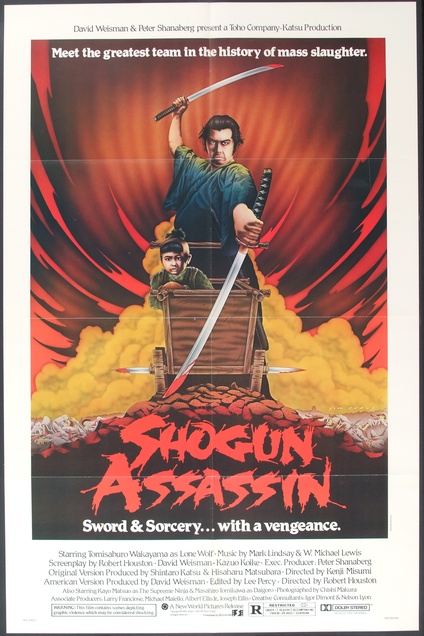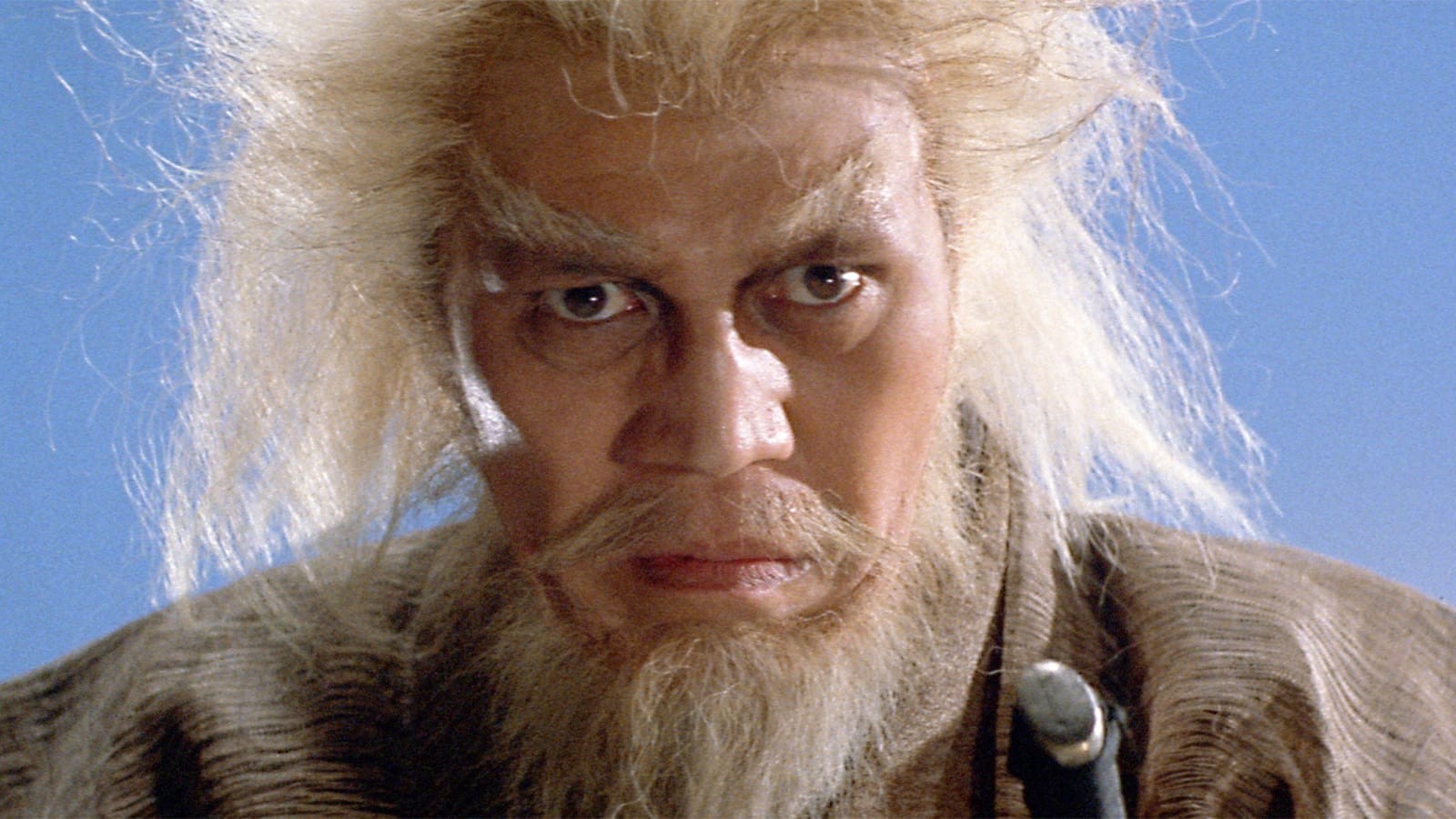 Japan’s LONE WOLF AND CUB/ KOZURE ÔKAMI film series (1972-74), based on the popular manga of the same name, was and remains one of the absolute wildest examples of Asian delirium from the seventies. Emerging from the mind of Kazuo Koike (who also created the CRYING FREEMAN, SAMURAI ASSASSIN and LADY SNOWBLOOD mangas), its conception of a masterless samurai wandering the outskirts of Edo-era Japan with his infant son in tow has proven quite durable, directly inspiring ROAD TO PERDITION (2002) and THE MANDALORIAN (2019), as well as a 1973 Japanese TV show and SHOGUN ASSASSIN (1980).
Japan’s LONE WOLF AND CUB/ KOZURE ÔKAMI film series (1972-74), based on the popular manga of the same name, was and remains one of the absolute wildest examples of Asian delirium from the seventies. Emerging from the mind of Kazuo Koike (who also created the CRYING FREEMAN, SAMURAI ASSASSIN and LADY SNOWBLOOD mangas), its conception of a masterless samurai wandering the outskirts of Edo-era Japan with his infant son in tow has proven quite durable, directly inspiring ROAD TO PERDITION (2002) and THE MANDALORIAN (2019), as well as a 1973 Japanese TV show and SHOGUN ASSASSIN (1980).
The latter emerged from actor/filmmaker Robert Houston (of THE HILLS HAVE EYES) and poster designer and sometime director David Weisman (CIAO MANHATTAN), who spent a reported six months taking the first two films of the series and transforming them into this English dubbed outrage. It was sold to Roger Corman’s New World Pictures, which in an effort to capitalize on the popularity of the 1980 SHOGUN TV miniseries titled the film SHOGUN ASSASSIN and released it to the “chop-socky” market of the early 1980s—where it was reportedly quite a mindblower. It later became a popular item on the 1990s VHS bootleg scene, and was finally released to DVD (by AnimEgo, who were also the first to digitize the LONE WOLF AND CUB films) in 2004—and to Blu-ray in 2010.
The major distinguishing feature of SHOGUN ASSASSIN is the fact that it’s narrated—in English—by the “cub.” Spoken in the voice of seven-year-old Gibran Evans, this kid’s voice-overs are used to fill in background detail and make oft-outrageous observations (“When we’re on a mission, I keep count of how many ninja my father kills. He says not to keep count, only to pray for their souls. But if I don’t keep count, I don’t know how many souls to pray for. So I keep count”).
About ten minutes’ worth of flashbacks (consisting of footage from SWORD OF VENGEANCE/KOZURE OKAMI: KO WO KASHI UDE KASHI TSUKAMATSURU, the first film in the LONE WOLF AND CUB series) fills us in on how the Lone Wolf and his son Daigoro came to be in their predicament. It seems the ruling Shogun, in a paranoid funk, ordered ninja assassins to Lone Wolf’s house to kill him; they failed, but succeeded in offing his wife.

Obsessed with vengeance, the Lone Wolf offers Daigoro a choice between a ball and a sword: if the boy crawls toward the ball he’ll join his mother in heaven (i.e. his father will kill him) but if he chooses the sword then he’ll join the old man on the road to hell. Needless to say, the boy chooses the sword and the two are off, in an odyssey whose footage emerges from BABY CART AT THE RIVER STYX/KOZURE OKAMI: SANZU NO KAWA NO UBAGURUMA, the second LONE WOLF AND CUB film.
Among the obstacles they face are shogun appointed ninjas infesting local towns (as the narration states, “sometimes you have to take a chance if you want to take a bath”), an army of female assassins, a trio of large hat wearing warriors and the shogun’s psychopathic brother. Lone Wolf handily dispatches them all, being possessed, evidently, of superhuman swordsmanship, and also a tricked-out wooden stroller that contains things like tubes that shoot arrows and spinning knives that jut out from the bottom (to cut off attackers’ feet). It ends just as it began, with the Lone Wolf and Cub heading off into the sunset.
Contrary to what you may have heard, the LONE WOLF AND CUB films—and by extension SHOGUN ASSASSIN—didn’t invent the arterial spray. Yet they did arguably take the device farther than anyone else, with enough spurting blood on display to fill the entirety of the FRIDAY THE 13TH franchise.
The fact that the first two installments of the LONE WOLF AND CUB series are far and away the best helps in rendering SHOGUN ASSASSIN a watchable and enjoyable film (and the reason why the sequel LIGHTNING SWORDS OF DEATH, a dubbed version of the not-as-good third film BABY CART TO HADES/KOZURE OKAMI: SHINIKAZENI MUKAU UBAGURUMA, wasn’t as popular). The director Kinji Misumi created consistently stylish and artistic films that, as is the case with many Japanese exploitation films from the seventies (such as SCHOOL OF THE HOLY BEAST/SEIJU GAKUEN and FEMALE PRISONER #701: SCORPION/JOSHU 701-GO: SASORI) often plays like an art film. Impeccably visualized images of blood bubbling up from sand as sharp points are stuck into it (because of people hiding below) and flaming men doing a synchronized somersault off the edge of ship are, I’d argue, as magisterial as anything by the art movie heavyweights of the seventies, and a whole lot more fun.
What Messrs. Houston and Wiseman add is a camp overlay, bequeathed by the goofiness of the child narration, an extremely dated electronic score by The Wonderland Philharmonic (Mark Lindsay and W. Michael Lewis), English dubbing that consists mostly of grunted and scowled dialogue (with a young Sandra Bernhard among the credited dubbers) and a re-editing job that plays down the artfulness of Misumi’s original film, placing the slashing and bloodletting center stage. Those wanting the full effect of Mizumi’s artistry are advised to watch the original films, but for those of you in the mood for pure exploitation delirium, here it is.
Vital Statistics
SHOGUN ASSASSIN
Katsu Production/Toho Company/New World Pictures
Directors: Kinji Misumi, Robert Houston
Producers: Shintarô Katsu, Hisaharu Matsubara, Robert Houston, David Weisman
Screenplay: Kazuo Koike, Goseki Kojima, Robert Houseman, David Weisman
(Based on a manga by Kazuo Koike)
Cinematography: Chishi Makiura
Editing: Toshio Taniguchi, Lee Percy
Cast: Tomisaburô Wakayama, Kayo Matsuo, Minoru Ôki, Shôgen Nitta, Shin Kishida, Masahiro Tomikawa, Lamont Johnson, Marshall Efron, Gibran Evans, Sandra Bernhard, Vic Davis, Lennie Weinrib, Lainie Cook, Sam Weisman, Mark Lindsay, Robert Houston, David Weisman, Reiko Kasahara
